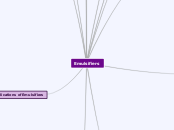Emulsifiers
dispersed two-phase system, i.e., an intimate mixture of two liquids that are immiscible under normal conditions, whereby one phase is
dispersed in the other in the form of fine droplets.
substances which reduce the surface tension at the interface of two normally immiscible phases, allowing them to mix and form an emulsion.
belong to the general class
of compounds called surface-active
agents or surfactants.
Emulsion
Two types of simple emulsion
water
in oil (w/o)
oil in water (o/w)
The stability of an emulsion depends on
degree of division of the inner phase
quality/stability of the interfacial film
viscosity of the outer phase
ratio & the specific weight of the
volumes of the two phases
Types of emulsifier
Nonionic
uncharged molecules relatively insensitive to effects of pH and salt content. Most commonly used food emulsifier type.
Example: mono- and diglycerides, sorbitan
esters, sucrose esters, polysorbates,
polyoxyethylene glycol oleates (all contain an – OH functional group)
Anionic
posess a negative electrical charge
e.g., Stearoyl lactylates, diacetyl tartaric esters of monoglycerides (DATEM), succinylated monoglycerides; functionality may be markedly influenced by pH and ionic strength.
Cationic
Possess a positive electrical
charge topic
e.g., amine compounds. Not used as food additive (toxic)
Amphoteric
Possess both positive and
negative charges
e.g., various lecithins; may
act as anionic or cationic emulsifier,
depending on pH of the system.
Properties of Some Common Food Emulsifiers
Mono- & Di-glycerides
Most commonly used emulsifiers
Highly lipophilic with HLB values
range from 1 to 10
Used in bakery products, frozen
desserts, icings, toppings, and
peanut butter
Sucrose Esters
Are the mono-, di-, and triesters
of sucrose with fatty acids
Usually with HLB values from 7
to 13
Sorbitan Esters
Produced by the reaction of
sorbitol and stearic acid
HLB = 4.7
Used in conjunction with
polysorbates in oil toppings,
cake mixes, etc.
Stearoyl Lactylates
example of ionic emulsifier
Form strong complex with
gluten in starch
Especially valuable in baked
products
Lecithin and Derivatives
example of amphipilic emulsifiers
Rich in egg yolk
Widely used in baked goods, low-fat baked
goods, chocolate, instant foods, confectionery
products, and cooking spray
Function of Emulsifier
emulsion stability, stabilize
aerated systems, and control
agglomeration of fat globules
modify texture, shelf life, and
rheological properties by complexing
with starch and protein components
improve the texture of fat-based foods by controlling the polymorphism
of fats
How does emulsifier work?
reduce surface tension between
the two immiscible phases due to their molecular structure.
have both a polar group with an affinity for water (hydrophilic), and a nonpolar group with an affinity for oil (lipohilic).
presence of both regions on the
emulsifier molecule allows them to
orient themselves at the phase
interface & lower the interfacial energy that leads to instability
stabilise emulsions by means of monomolecular interfacial
films & also by formation of steric and/ or electrical barriers that prevent
coalescence of the dispersed droplets
Hydrophilic-Liphophilic Balance (HLB)
expresses the balance of size and
strength of the hydrophilic (water loving or polar) and the lipophilic (oil loving or nonpolar) groups on the emulsifierSubtopic
High HLB values (HLB > 10) indicate
relatively more polar (hydrophilic)
molecules; More lipophilic emulsifiers have HLB values from 1 – 10
used to describe the emulsifying properties of nonionic emulsifiers
" HLB of 3 – 6 : a good w/o emulsifier
" HLB of 7 – 9 : a good wetting agent; can be used for w/o or o/w emulsifier
" HLB of 10 – 18 : a good o/w emulsifier
Applications of Emulsifiers
Bread, Rolls, Buns
Dough conditioning/strengthening – emulsifiers that aid in development of less tacky, more extensible dough that are processed through machinery
without tearing or sticking – exert their effect during fermentation, mechanical handling, shaping and transport, as well as during proofing and the first part the baking time
Examples of dough conditioners: calcium
stearoyl lactylate, sodium stearoyl lactylate (SSL), ethoxylated onoglycerides (EOM), succinylated monoglycerides (SMG), and polyoxyethylene sorbitan monostearate (PS60)
Cakes
Cake batters have been described as complex w/o emulsions or air-in-fat foams, consisting of suspended flour particles, dissolved sugar, and proteins.
Emulsifiers added to fat-containing batters function to (1) stabilize the aerated structure and (2) promote a finer distribution of the fat droplets.
Confectionery Products & Coatings
Emulsifiers are used primarily to
inhibit bloom, stabilize gloss, &
improve palatability
The bloom defect can be retarded with
the use of emulsifiers functioning as
crystal modifiers
Frozen dairy products – Ice Cream
function as aerating
agent and foam
stabiliser
emulsifiers
stabilize the foam by
actually de-stabilizing
the product's emulsion.
displace the protein from the fat globule surface to the aqueous phase
Noodle & Pasta
make a rigid complex with
starch to protect starch granules and
improve the quality of starchy foods
fresh noodles, an emulsifier makes easy
to handle dough and increases the water
absorption rate by 1 to 2%.
macaroni and spaghetti, emulsifiers
provide a feeling of elasticity, and a
smooth uniform surface which inhibits
sticking after boiling.
How to Select an Emulsifier?
Select an emulsifier after considering the functional requirements of the food system, the method of processing, and the form of the finished product
Determine the HLB requirements for the food system – involves screening emulsifiers over a range of HLB
values & several concentrations
